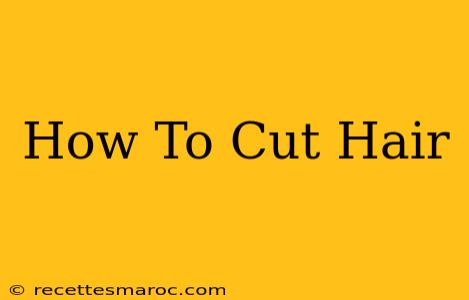Cutting your own hair might seem daunting, but with the right tools and techniques, you can achieve surprisingly good results. Whether you're aiming for a simple trim or a more dramatic style change, this comprehensive guide will walk you through the process step-by-step. Remember, practice makes perfect! Don't be afraid to start small and gradually build your confidence.
Getting Started: Essential Tools and Preparation
Before you even think about picking up scissors, gather your supplies. Having everything ready will make the process much smoother and less stressful.
Essential Tools:
- Sharp Hair Cutting Scissors: This is crucial. Dull scissors will cause split ends and an uneven cut. Invest in a good quality pair specifically designed for hair.
- Hair Clips: These are vital for sectioning your hair, especially for longer cuts.
- Wide-Tooth Comb: Use this to detangle your hair and create neat sections.
- Spray Bottle: Keeps your hair damp for easier cutting.
- Mirror: You'll need at least one, and a second mirror for the back of your head is highly recommended.
- Optional: Hair Cutting Shears (Thinning Shears): These are helpful for blending and softening the overall look, especially if you're aiming for layers.
Preparing Your Hair:
- Clean, Dry Hair: Start with freshly washed, completely dry hair. This allows you to see the true length and texture. If you're aiming for precision, dry hair is best. For very thick or curly hair, slightly damp hair may be easier to manage.
- Detangle Thoroughly: Make sure there are no knots or tangles before you begin cutting.
- Section Your Hair: Divide your hair into manageable sections using clips. The number of sections will depend on the length and style of your hair.
Basic Cutting Techniques: From Trims to Layers
Now for the actual cutting! We'll cover some basic techniques:
Trimming Split Ends:
This is the easiest cut for beginners.
- Section your hair: Work with small sections at a time.
- Hold the hair: Gently hold a section of hair taut between your fingers.
- Cut straight across: Use sharp scissors to trim the very ends, aiming for a straight, even cut. Avoid snipping upwards.
Creating Layers:
Layering adds volume and texture. This is more advanced, but achievable with practice.
- Gather a section of hair: Begin with the top section of your hair.
- Pull the hair forward: Pull the section forward and away from your head.
- Point cut: Use the tips of your scissors to create short, angled cuts along the ends of your hair section. This method creates soft layers.
- Repeat: Repeat this process with other sections, adjusting the angle to create different layering effects. Be mindful of maintaining evenness across the layers.
Cutting Blunt Bangs:
Bangs are a bold statement, so take your time.
- Section your hair: Clearly define the area you want to use for your bangs.
- Hold the hair taut: Hold the section taut between your index and middle fingers.
- Cut straight across: Aim for a straight, even cut at your desired length. Remember, it's better to cut a little less at first, as you can always trim more later.
Tips for Success:
- Start small: Don't try to do too much at once. Begin with small trims and gradually work your way to more significant changes.
- Work in sections: This will ensure evenness and help you avoid mistakes.
- Take your time: Rushing will lead to mistakes. Be patient and methodical.
- Use sharp scissors: Dull scissors will cause damage to your hair.
- Practice: The more you practice, the better you'll become at cutting your own hair.
When to Seek Professional Help:
While cutting your own hair can be satisfying, some styles are best left to the professionals. For complex cuts, color treatments, or significant changes, visit a reputable hair stylist.
This comprehensive guide provides a foundational understanding of how to cut hair at home. Remember to always prioritize safety and take your time to achieve the desired results. Happy cutting!

